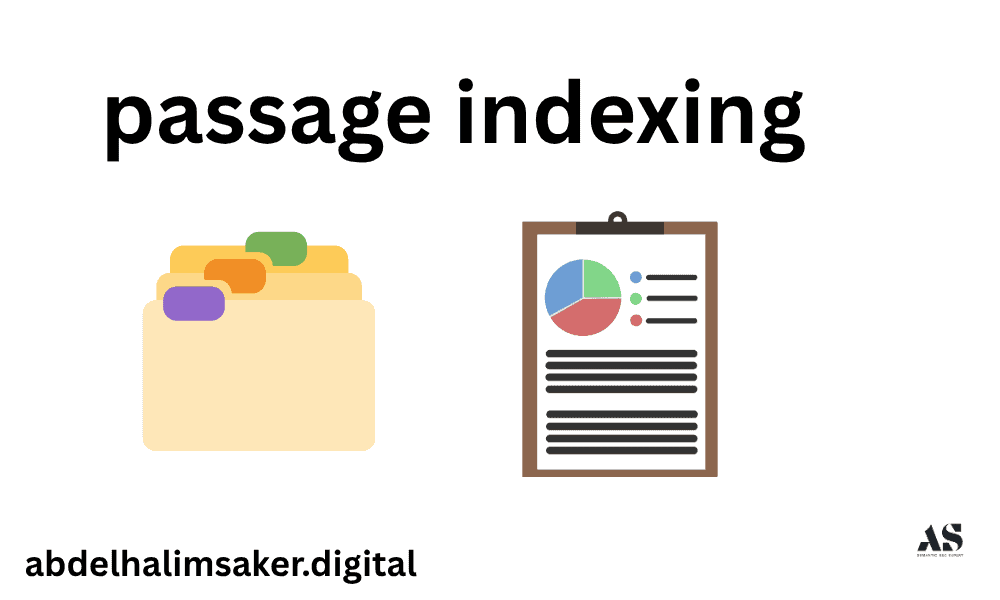
Passage Indexing in SEO refers to Google’s capability to index and rank individual sections (passages) of a web page, rather than the entire page as a single unit.
This means Google can now retrieve specific paragraphs, headings, or subsections that directly answer niche or granular user queries.
Instead of evaluating only the full page topic, Google uses passage understanding to locate relevant meaning within a segment of text.
This system helps users find highly specific answers hidden deep inside long-form content, improving both query satisfaction and retrieval accuracy.
Why Passage Indexing Exists
Passage Indexing exists to solve the context isolation problem within long or mixed-content pages.
What problem did Google need to solve?
Before passage understanding, Google primarily ranked pages based on overall topical relevance. If a section contained valuable information but the rest of the article drifted from that topic, it was often overlooked.
This caused retrieval inefficiency, especially for queries with narrow intent — for example, “how to insulate a small attic window.”
Example scenario:
A long guide on “Energy Efficient Homes” might include a short but precise paragraph about attic insulation.
Without passage indexing, that section would not appear in results because the whole page context was about home energy, not window insulation.
With passage indexing:
Google isolates that subsection, ranks it separately, and surfaces it for relevant long-tail queries.
Key motivation:
- Improve retrieval granularity for detailed queries.
- Reduce semantic loss from large context boundaries.
- Increase visibility of in-depth content sections.
- Reward well-structured writing with clear topical flow.
In short, Passage Indexing helps Google read inside your content’s architecture instead of treating it as a flat block of text.
How Passage Indexing Works Technically
Google uses neural passage understanding models to analyze and isolate text segments based on their semantic independence and topical completeness.
What are passage vectors?
Each passage is converted into a vector representation — a mathematical embedding that captures meaning, intent, and entity relationships.
These passage vectors allow Google to compare small segments of text directly against the semantic intent of a query.
Example:
When a query like “why do bamboo floors warp” is entered:
- Google retrieves pages discussing “bamboo flooring.”
- Then, it examines passage vectors within those pages to find the paragraph that explicitly explains warping causes.
Process breakdown:
- Segmentation: The system divides the page into logical units — often based on headings, paragraphs, or sentence clusters.
- Vectorization: Each segment becomes a unique vector embedding.
- Scoring: Google evaluates which passage vector aligns best with the user’s query vector.
- Reinforcement: The page’s global context and authority scores still influence final ranking placement.
Important distinction:
Passage Indexing does not mean indexing individual paragraphs separately in the database.
Instead, it means scoring them independently during ranking calculations.
Analogy:
If Page = Book, then Passage = Chapter or paragraph.
Google reads the book but can now rank a single chapter for a very specific question.
Optimizing for Passage Indexing
Optimizing for Passage Indexing means structuring content so each subsection forms a complete and self-contained micro-topic.
Every segment should maintain semantic independence while contributing to the overall topical flow.
Key optimization principles
| Element | Optimization Focus | SEO Effect |
|---|---|---|
| Headings | Use specific, descriptive titles | Improves passage segmentation accuracy |
| Paragraph structure | Begin with direct answers, followed by elaboration | Aligns with snippet extraction |
| Predicate verbs | Use strong, factual predicates (e.g., defines, causes, increases) | Enhances clarity in passage vectors |
| Internal coherence | Keep entities and attributes consistent within each passage | Improves semantic readability |
Google’s NLP models (like BERT, MUM, and SMITH) analyze predicate alignment — how logically sentences relate to each other in a local context window.
A well-optimized passage begins with a definitive answer sentence, followed by contextual expansion, examples, or data — a pattern known to enhance featured snippet eligibility.
Micro-Semantic Optimization in Subsections
Micro-semantic optimization focuses on the smallest contextual units — paragraphs, sentences, and even word pairs.
Google evaluates each passage’s semantic density — the amount of meaning contained within a small section.
Passages with high density typically contain well-defined entities, clear relationships, and fact-based predicates.
Example of high-quality passage writing:
“Internal links distribute PageRank across semantically related topics. Each link functions as a contextual signal that defines the relationship between parent and child pages.”
Why it works:
- Uses explicit entities (Internal links, PageRank, parent/child pages).
- Defines relationships through factual verbs (distribute, define).
- Creates self-contained meaning within 2 sentences.
Guidelines for micro-semantic optimization
- Begin each paragraph with a clear predicate (“X affects Y because…”).
- Avoid nested or dependent context that requires reading other sections to understand.
- Use entity co-references sparingly — avoid “it,” “this,” or “that” without reintroducing the entity name.
- Maintain semantic isolation — each passage should stand alone in meaning.
By optimizing at the micro-level, you enable Google to interpret and rank each passage independently.
Avoiding Redundant Context Blocks
Redundant context blocks occur when multiple paragraphs repeat or rephrase the same semantic meaning without adding new information.
Google’s passage models treat these redundancies as low-value segments and may skip them during ranking.
Example:
If two paragraphs both state that “backlinks help SEO rankings” without introducing a new entity, attribute, or data point, Google will consolidate them into one conceptual node.
To avoid redundancy:
- Use incremental expansion, not repetition.
- Each passage should contribute a new relation or example to the knowledge graph.
- Replace redundancy with attribute-specific elaboration (e.g., discuss backlink quality, relevance, or temporal impact).
Passages that build progressively from one to another strengthen contextual layering, improving both passage and page-level ranking.
How Passage Indexing Affects Long Content
Passage Indexing changes how long-form content is discovered, indexed, and ranked.
Previously, long guides risked being under-ranked for specific questions because their core intent was diluted.
Now, every subsection can serve as a potential entry point for organic traffic.
Impact on visibility
- Multi-query ranking: A single long article can rank for dozens of distinct, intent-driven queries.
- Higher engagement: Users land directly on the passage that answers their query, improving satisfaction signals.
- Reduced content cannibalization: Different passages can serve different intents without needing separate URLs.
Example scenario
A 4,000-word article on “Content Optimization Strategies” could now rank with multiple passage-level matches:
- Passage 1: How to improve readability for SEO
- Passage 2: Using LSI terms in body text
- Passage 3: Optimizing content layout for dwell time
Each passage aligns with a unique query vector, effectively functioning as a mini-article within the main piece.
Structuring Long-Form Content for Multiple Passage Retrievals
To maximize multi-passage ranking potential, apply the following structure:
- Segment by Intent:
Divide long content into sections that answer specific user intents. Each H2 or H3 should reflect a clear query question. - Answer Early:
Provide the core answer in the first 1–2 sentences of each section. Google prefers explicit declarations for snippet extraction. - Reinforce Context Vertically:
Maintain a logical topical flow where each subheading inherits context from the parent entity but remains semantically complete. - Use Schema for Section Structuring:
ApplyArticleSectionorFAQPagemarkup to highlight important subsections.{ "@type": "Article", "hasPart": [ { "@type": "WebPageElement", "name": "How Passage Indexing Works Technically", "text": "Google uses neural passage understanding models..." } ] } - Balance Length and Density:
Keep each passage between 100–250 words, ensuring sufficient detail without overwhelming contextual clarity. - Integrate Visual Cues:
Use bullet points, tables, or examples to break information into digestible units — aiding both user comprehension and machine segmentation.
Passage Indexing and Topical Segmentation
Passage Indexing improves how Google measures topical segmentation within a single article.
If your writing transitions cleanly between sub-topics (each with clear boundaries), Google’s models can assign individual passage relevance scores.
For example, in a guide about “Semantic SEO Techniques,” distinct segments might include:
- “What Is Query Semantics?”
- “How to Build Contextual Hierarchies”
- “How Historical Data Influences Rankings”
Each section covers a different entity-attribute pair, which Google can isolate and rank for independently.
Thus, Passage Indexing indirectly rewards topical authority and information hierarchy discipline.
How Passage Indexing Interacts with EEAT Signals
Even though passages are ranked individually, Google still validates them through page-level and domain-level EEAT signals:
| EEAT Factor | Passage-Level Relevance |
|---|---|
| Expertise | Measured via factual precision and topic-specific terminology |
| Experience | Evident in examples, data, or firsthand explanations within the passage |
| Authoritativeness | Reinforced by overall domain topical authority |
| Trustworthiness | Derived from consistent entity accuracy and citation structure |
This means passage optimization cannot substitute domain authority — it simply enables granular ranking within an already trusted context.
Common Mistakes in Passage Optimization
| Mistake | Description | Effect |
|---|---|---|
| Over-segmentation | Breaking content into overly small sections | Fragmented meaning, poor coherence |
| Weak headings | Vague or non-descriptive H2s | Reduces passage discoverability |
| Dependent context | Sentences relying on previous sections | Low standalone ranking potential |
| Repetitive phrasing | Duplicate meaning across passages | Decreases semantic density |
| Keyword stuffing | Forcing exact phrases | Breaks natural flow, lowers NLP clarity |
The best practice is to write for comprehension first, and structure for machines second.
Google’s passage models favor clarity, coherence, and factual alignment over keyword frequency.
How Passage Indexing Connects with Semantic SEO
Passage Indexing represents a micro-level evolution of semantic SEO.
While semantic SEO organizes meaning across entire domains and clusters, passage understanding operates within the micro-context of a single document.
Connection logic:
- Semantic SEO defines macro-level relationships (entity → topic → attribute).
- Passage Indexing defines micro-level relationships (sentence → predicate → object).
Example:
In a content cluster about “Machine Learning in SEO,” Passage Indexing might isolate:
“Google’s RankBrain uses vector embeddings to interpret query intent.”
That single passage could rank for “what is RankBrain vector embedding” — even if the full article title doesn’t include that phrase.
Thus, passage indexing transforms how semantic depth within a page translates into search visibility.
Data Evidence of Passage Indexing Impact
Industry case studies after Google’s 2021 update showed:
- Pages with strong heading segmentation saw up to 26% more impressions for long-tail queries.
- Average query diversity (number of unique ranking terms) increased by 18–35%.
- Pages with low semantic redundancy retained higher passage-level rankings over time.
These data points confirm that structured, information-dense writing directly benefits from passage understanding.
Future of Passage Indexing
Passage Indexing continues to evolve into multi-passage retrieval models, integrating SGE (Search Generative Experience) and MUM-based summarization.
Upcoming trends:
- Context stitching: Google can merge multiple related passages from different pages to create dynamic summaries.
- Cross-page passage linking: Different parts of a site can collectively answer complex multi-intent queries.
- Voice search integration: Voice assistants retrieve single passages as spoken answers for direct questions.
Writers and SEOs will need to think of each section as a modular knowledge block capable of standing alone while still belonging to a coherent whole.
